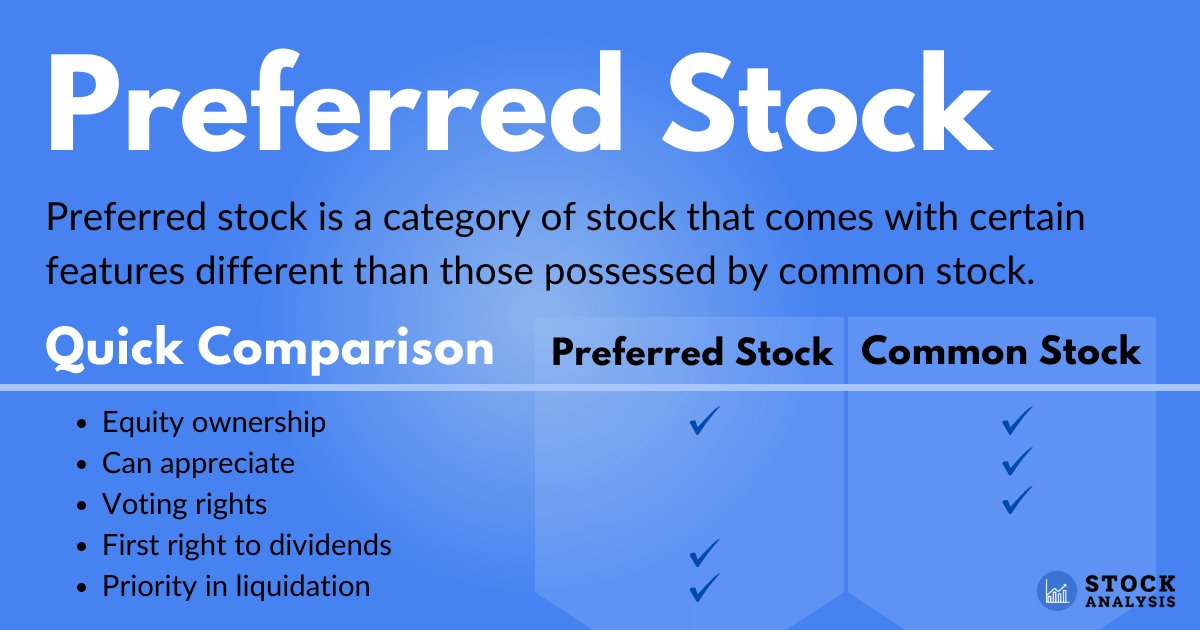Preferred Stock
Preferred stock is a category of stock that comes with certain rights or features that are different than those granted to common stockholders.
Preferred stock shares may include aspects of both debt and equity instruments, making them somewhat of a hybrid stock form.
Preferred stock is also called preferred shares, preferreds, or sometimes preference shares.
Here is a complete guide to preferred stock, including benefits and limitations, types, and how these shares compare to bonds and common stock.
What is preferred stock?

Preferred stock is a class of stock that can have both debt and equity characteristics.
For this reason, it can share features with both common stock and bonds, though it has some unique privileges attached to it as well.
Like bonds, the value of preferred shares is sensitive to interest rate changes. And like common stock, preferred shares represent a form of equity in the company.
Importantly, preferred stock shares offer some privileges that are not available to those holding common stock shares. For example, preferred stockholders have a greater claim on assets in the event of a liquidation. They also have a greater claim on dividends.
However, preferred shares rarely give the holder the right to vote on the company's corporate governance, so preferred shareholders have no control over the business's management.
The terms of the preferred stock will be outlined in the company's articles of association or incorporation.
Of note, insurance companies and banks are the kinds of companies most likely to offer preferred shares.
SummaryPreferred stock is a class of stock that has certain rights assigned to it, such as a greater claim on assets following a liquidation. It differs from common stock in that it does not grant voting rights.
Benefits of preferred stock
Preferred stock has several beneficial features, such as higher dividends, increased protection in the event of company liquidation, and price stability.
Higher dividends
One of the biggest benefits of preferred stock is the dividends, which are:
- Often fixed at a certain rate, though not always.
- Usually much greater than those offered to common stockholders.
- Set to occur at regular intervals.
- Prioritized over common stock dividends.
Common stock does not offer this level of certainty when it comes to dividends, because payments may decrease or stop entirely.
Moreover, preferred stock dividends are paid before common stock dividends.
This predictability is a major feature of preferred stock and often attracts buy-and-hold investors focused on a long-term strategy designed to accumulate dividend income.
More protection
Preferred shareholders have priority over common shareholders if the company is forced to liquidate. In this scenario, preferred shareholders have a prior claim on the company's assets.
However, it should be noted that bondholders still have priority over preferred shareholders.
Price stability
The price of preferred shares is generally more stable than that of common stock.
Preferreds are generally issued with a par value, or face value, and trade more similarly to bonds, with sensitivity to interest rates. What this means is that you're not investing for growth necessarily, but rather for the income.
As a preferred shareholder, you're not likely to experience a sharp rise or even a gradual long-term rise in the share price if the company becomes successful.
However, there are some scenarios in which a preferred shareholder could experience capital gains, such as:
- Buying a preferred stock before an interest rate drop.
- Owning preferred stock when the firm's creditworthiness increases.
For most preferred shareholders, the true value of the shares is the size and predictability of the dividends, not a potentially larger future share price.
SummaryPreferred stock comes with several advantages, including more predictable dividends, some protection if the company were to liquidate, and stable value.
Limitations of preferred stock
Alongside the benefits come a few drawbacks, such as no voting rights and a lack of growth.
No voting rights
Preferred shares rarely offer voting rights. Consequently, the holder has no say in the decisions made by the executives or in the management of the company.
While this may not be a serious drawback for investors, there could be a scenario in which a major proxy vote outcome has a big influence on the future of the company and, by extension, the value of the preferred stock.
Price stability
Preferred shares do not rise and fall in value the way common shares do.
This means that preferred shareholders do not get to participate in the capital gains that may come from holding common stock in companies experiencing share price appreciation.
However, this can be either a benefit or limitation, depending on how you look at it and what your investment strategy is.
SummaryThe downside of preferred stock is the lack of voting rights and the fact that preferred shares don't have the opportunity to majorly appreciate in value.
Types of preferred stock
There are four main types of preferred stock: convertible, callable, cumulative, and participatory.
1. Convertible
These shares of preferred stock can be converted later on to common shares.
Some investors might want this type of preferred stock because they may want to capitalize on a rising share price. However, note that the conversion is a one-time thing.
Companies often use convertible shares in early-stage financing. This offers early investors a return with the opportunity for growth in the company.
The downside, of course, is that the conversion opportunity may not appreciate, or could even depreciate, depending on how the company performs.
2. Callable
With this type of stock, the issuing company has the right to call, or repurchase, the shares at a set price on a defined date.
The company might choose to do this if they decide the interest rates they're required to pay are too burdensome. The call price, the call date, and the call premium, which is not always offered, are all clearly defined in the prospectus. None of these can be changed later.
Callable preferred stock gives the issuer flexibility.
For example, they might issue 6% preferred shares. Then, when interest rates decrease, they may choose to issue preferred shares at 4%, allowing them to call in the more expensive shares and issue new ones at a lower dividend rate.
The investor's advantage is that the issuer usually pays a call premium upon the redemption of the preferred issue, which compensates the investor for having to sell the shares.
Also, if the issuer has additional optionality, they must pay the investors for it.
3. Cumulative
Cumulative preferred stock includes a provision stating that if the issuer misses any dividend payments they must pay all of those missed payments before making any dividend payments to common shareholders or other classes of preferred stock shareholders.
Those holding common stock or preferred shares that are not cumulative simply miss out if a dividend payment is not made.
Cumulative preferred stock is good to have when a company encounters financial hardship and then recovers. After the recovery, the cumulative preferred stock shareholders get to catch up on the payments they did not receive.
4. Participatory
Participatory preferred stock allows the holder to participate in higher-than-expected revenues.
These shareholders can receive higher dividend payments than the fixed amount if the issuing company generates more revenue than anticipated.
Typically, this additional payment happens when the common share dividend is higher than the preferred share dividend.
For example, let's say a company issues participating preferred shares at a dividend rate of $2.50 per share. Then, the company announces it will pay a dividend of $3.00 per share for common shares. Preferred shareholders will receive the higher payment, so $3.00.
SummaryThere are four kinds of preferred shares: convertible, callable, cumulative, and participatory. All of them offer unique benefits to the holder.
Preferred stock vs. common stock and bonds
While preferred stock shares some similarities with common stock and bonds, there are a few key differences as well.
Preferred stock vs common stock
Similarities
Preferred stock and common stock both:
- Offer equity ownership in a company.
- Are tradeable on public exchanges.
Differences
Preferred stock and common stock differ because preferred stock:
- Has first right to dividends, while common stock does not guarantee dividends.
- Rarely generates any chance at capital appreciation, while common stock does.
- Offers priority to holders in event of liquidation, whereas common stock does not.
- Is sometimes convertible to common stock but common cannot be converted to preferred.
- Holds no voting rights, while common stock does.
Preferred stock vs bonds
Similarities
Preferred stock and bonds both:
- Offer recurring cash distributions.
- Are offered at par value or face value.
Differences
Preferred stock and bonds differ because preferred stock:
- Is prioritized above common stock in liquidation, though bonds are prioritized above all.
- Rarely has an end date, while bonds have a fixed term or maturity date.
- Can experience changes in dividend amounts, while bonds often have set interest payments, though not always.
SummaryThe main differences between preferred stock, common stock, and bonds are the rights they grant the shareholder.
Comparison guide
Below is a table that summarizes the similarities and differences discussed above.
| Preferred stock | Common stock | Bonds | |
| Equity ownership | Yes | Yes | N/A |
| Tradable on public exchanges | Yes | Yes | No |
| First right to dividends | Yes | No | N/A |
| Can appreciate | No | Yes | N/A |
| Priority in liquidation | Yes | No | Top priority |
| Convertible | Yes | No | N/A |
| Voting rights | No | Yes | N/A |
| Recurring cash distribution | Yes | No | Yes |
| Offered at face value | Yes | No | Yes |
| Maturity date | No | N/A | Yes |
| Payments can fluctuate | Yes | Yes | No |
The takeaway
Preferred stock is a class of stock granting certain rights to shareholders. These differ from the rights associated with common stock, though there are pros and cons to each.
The main differences are which rights are granted to shareholders and how the returns work.
Preferred stock is often favored by investors who want relatively high dividend payments that offer consistency and some downside protection in the event of the issuer experiencing financial hardship or even liquidation.
There are four kinds of preferred shares, all of which offer unique benefits to the holder. There is no optimal type — choosing the right kind means knowing which best suits the investor's goals.





